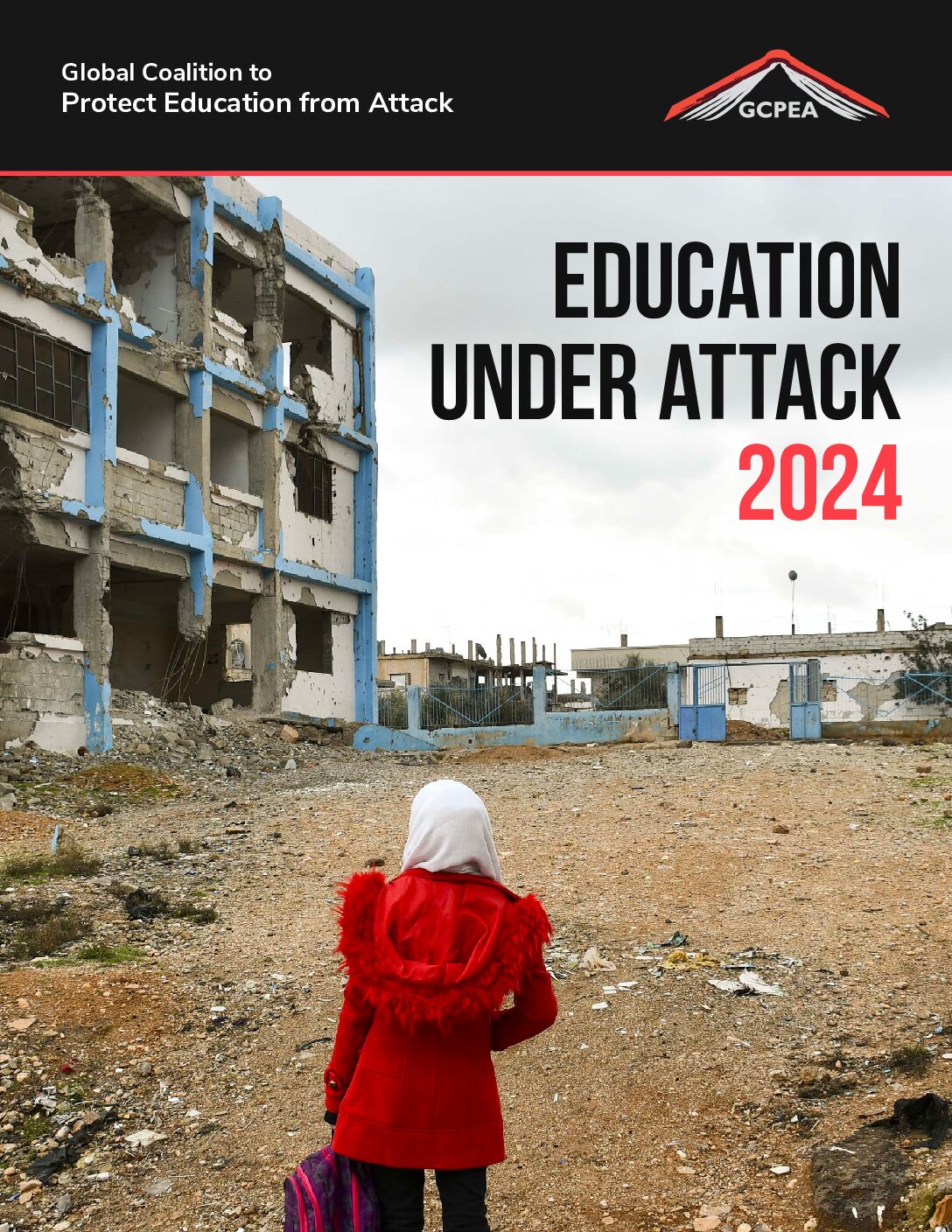GCPEA News
Attacking Education a War Tactic Globally, Study Shows
Sub-Saharan Africa highly impacted Colombia and Mexico Highly Impacted Seven Asian Countries Highly Impacted Middle East and North Africa Highly Impacted
Global Coalition to Protect Education from Attack, February 26, 2014
(New York, February 27, 2014) – Schools and universities, as well as students, teachers and academics are intentionally targeted for attack in conflicts worldwide, the Global Coalition to Protect Education from Attack said in a 250 page study released today. Education Under Attack 2014 identifies 30 countries (see map) where there was a pattern of deliberate attacks between 2009 and 2013, including nine in Sub-Saharan Africa: Central African Republic (CAR), Côte d’Ivoire, Democratic Republic of the Congo (DRC), Ethiopia, Kenya, Mali, Nigeria, Somalia and Zimbabwe.
“Education facilities, students and staff are not just caught in the crossfire, but are all too often the targets of attacks,” said Diya Nijhowne, director of the Global Coalition. “They are bombed, burned, shot, threatened and abducted precisely because of their connection to education. They are soft, easy targets, and states and armed groups need to protect them from being used as a tactic of war.”
Both armed non-state groups and national military and security forces are attacking education to advance their own interests, the Global Coalition said. They may be retaliating against a community’s perceived support for the opposition; seeking to demonstrate a lack of government control by harming schools and teachers, symbols of the state; attacking forces based in or using a school building; or opposing the spread of ideas deemed to be objectionable, such as the education of girls.
“Attacks on education in the last five years have killed hundreds of students, teachers, and academics and injured many more,” Nijhowne said. “Hundreds of thousands of students have been denied the right to an education when their schools and universities have been intentionally damaged or destroyed or used for military purposes.”
The conflict in Côte d’Ivoire is a grave example. During the 2010-2011 post-election crisis, armed groups and national military forces destroyed, damaged, looted or used almost 500 schools and universities.
In the wake of the Séléka rebellion in CAR in late 2012 and 2013, more than 100 schools were looted or vandalized by rebels, soldiers and local populations, and several were intentionally attacked – sprayed with bullets, shelled or set on fire. Séléka members reportedly entered one school and told students if they returned to class they would be taken hostage.
In 25 of the 30 countries profiled in the study, including eight in Africa (see map), warring parties took over schools in whole or part, using them as bases, barracks, firing positions, weapons caches, detention and torture centers and even mass graves.
Buildings that should have been safe spaces for learning became actual battlefields when military use made them a target for attack. In Somalia, where armed militants fought government forces from bases in schools, one boy recalled a terrifying incident during class in 2010: “The school was hit by a weapon that sounded like thunder when coming and then made a big explosion.” Three children died in that attack and six were injured.
In ideological rifts turned violent, education can be a primary target. In July 2013, gunmen attacked a boarding school dormitory in northern Nigeria, setting it on fire at night while students were sleeping and shooting many who tried to escape. At least 22 students and one teacher were killed. In a video statement released shortly afterwards, Abubakar Shekau, leader of the militant Islamist group Boko Haram, endorsed attacks on schools and said: “School teachers who are teaching Western education? We will kill them! We will kill them!” The government’s response in many instances has been to close schools, sometimes for months, effectively blocking access to education.
Schools are also sites where armed groups kidnap children and compel them to fight or serve in other ways. A 17-year-old student in the North Kivu province of the DRC reported that in April 2012, armed men entered his school near the end of classes, tied students’ hands and marched them off the premises to join the forces fighting for rebel general Bosco Ntaganda.
The Global Coalition also examined assaults on higher education, which have been monitored less than attacks on elementary and secondary schools. Colleges, universities and individual students and academics were attacked in 28 of the 30 profiled countries (see map), including eight countries in Africa. Throughout Ethiopia, for example, security agents have arrested and detained university students, particularly those involved in or perceived to be supporters of the insurgent Oromo Liberation Front, in an attempt to silence political protest.
Between 2009 and 2013, the Global Coalition found, students and educators in Africa were most at risk in three heavily or very heavily affected countries (Côte d’Ivoire, DRC and Somalia), where in each case there were reports of at least 500 incidents of attacks or military use of schools or 500 education-related victims, and at the higher end more than 1,000 attacks or victims.
In compiling the data, the Global Coalition relied mainly on information provided by the United Nations, respected human rights organizations and the media. They also interviewed country experts and commissioned some research locally. Education under Attack 2014 follows two reports by UNESCO, in 2007 and 2010.
The Global Coalition also explored ways of protecting education. These include: investigating attacks and prosecuting perpetrators; negotiating with belligerent parties to respect schools as safe zones; ending the use of schools and teachers for electoral tasks in conflict areas; ensuring equitable access of different identity groups to education; and improving curricula to address perceptions that education is biased and to build respect for diversity.
In particular, the Global Coalition called for widespread adoption of the Lucens Guidelines for Protecting Schools and Universities from Military Use during Armed Conflict. The Guidelines draw on international human rights and humanitarian law as well as good practice to preserve education as a sanctuary in conflict.



